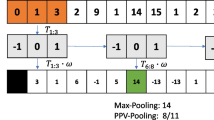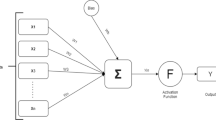Abstract
Financial time series forecasting has become a challenge because of its long-memory, thick tails and volatility persistence. Multifractal process has recently been proposed as a new formalism for this problem. An iterative Markov-Switching Multifractal (MSM) model was introduced to the literature. It is able to capture many of the important stylized features of the financial time series, including long-memory in volatility, volatility clustering, and return outliers. The model delivers stronger performance both in- and out-of-sample than GARCH-type models in long-term forecasts. To enhance MSM’s short-term prediction accuracy, this paper proposes a support vector machine (SVM) based MSM approach which exploits MSM model to forecast volatility and SVM to model the innovations. To verify the effectiveness of the proposed approach, two stock indexes in the Chinese A-share market are chosen as the forecasting targets. Comparing with some existing state-of-the-art models, the proposed approach gives superior results. It indicates that the proposed model provides a promising alternative to financial short-term volatility prediction.



Similar content being viewed by others

References
Poon S, Granger C (2003) Forecasting volatility in financial markets: a review. J Econ Lit 41(2):478–539
Mandelbrot B (1974) Intermittent turbulence in self-similar cascades: divergence of high moments and dimension of the carrier. J Fluid Mech 62(02):331–358
Vassilicos J, Hunt J (1993) Turbulent flamelet propagation. Combus Sci Technol 87(1):291–327
Mandelbrot B, Fisher A, Calvet L (1997) The multifractal model of asset returns. Cowles Foundation discussion paper no. 1164, Yale University, paper available from the SSRN database at http://www.ssrn.com
Calvet L, Fisher A (2002) Multifractality in asset returns: theory and evidence. Rev Econ Stat 84(3):381–406
Calvet L, Fisher A (2001) Forecasting multifractal volatility. J Econom 105(1):27–58
Calvet L, Fisher A (2004) How to forecast long-run volatility: regime switching and the estimation of multifractal processes. J Finan Econom 2(1):49
Calvet LE, Fisher AJ, Thompson SB (2006) Volatility comovement: a multifrequency approach. J Econom 131(1-2):179–215
Lux T, Kaizoji T (2007) Forecasting volatility and volume in the Tokyo stock market: Long memory, fractality and regime switching. J Econ Dyn Control 31(6):1808–1843
Idier J (2010) Long-term vs. short-term comovements in stock markets: the use of Markov-switching multifractal models. Eur J Finance 99999(1):1–22
Vapnik V (2000) The nature of statistical learning theory. Springer, Berlin
Tay F, Cao L (2002) Modified support vector machines in financial time series forecasting. Neurocomputing 48(1–4):847–861
Kim K (2003) Financial time series forecasting using support vector machines. Neurocomputing 55(1–2):307–319
Cao L, Tay F (2004) Support vector machine with adaptive parameters in financial time series forecasting. Neural Netw IEEE Trans 14(6):1506–1518
Chatfield C (1988) What is the best method of forecasting? J Appl Stat 15(1):19–38
Makridakis S (1989) Why combining works? Int J Forecast 5(4):601–603
Makridakis S, Andersen A, Carbone R, Fildes R, Hibon M, Lewandowski R, Newton J, Parzen E, Winkler R (1982) The accuracy of extrapolation (time series) methods: results of a forecasting competition. J Forecast 1(2):111–153
Zhang G (2003) Time series forecasting using a hybrid ARIMA and neural network model. Neurocomputing 50:159–175
Granger C, Joyeux R (1980) An introduction to long-memory time series models and fractional differencing. J Time Ser Anal 1(1):15–29
Brailsford T, Faff R (1996) An evaluation of volatility forecasting techniques. J Bank Finance 20(3):419–438
MF (2010) Empirical evidence for multifractals in finance. Available at http://www.multifractal-finance.com/resources/35-articles/61-empirical-evidence-for-multifractals-in-finance
Galluccio S, Caldarelli G, Marsili M, Zhang Y (1997) Scaling in currency exchange. Phys A Stat Theor Phys 245(3-4):423–436
Ghashghaie S, Breymann W, Peinke J, Talkner P, Dodge Y (1996) Turbulent cascades in foreign exchange markets. Nature 381(6585):767–770
Pasquini M, Serva M (2000) Clustering of volatility as a multiscale phenomenon. Eur Phys J B 16(1):195–201
Richards G (2000) The fractal structure of exchange rates: measurement and forecasting. J Int Finan Markets Inst Money 10:163–180
Bacry E, Delour J, Muzy J (2001) Multifractal random walk. Phys Rev E 64(2):26103
Bacry E, Kozhemyak A, Muzy J (2008) Continuous cascade models for asset returns. J Econ Dyn Control 32(1):156–199
Breymann W (2006) Theory of financial risk and derivative pricing: from statistical physics to risk management. J Am Stat Assoc 101(474):850–852
Lux T (2008) The Markov-switching multifractal model of asset returns. J Bus Econ Stat 26(2):194–210
Riabushenko A (2008) Multifractal model: forecasting stock returns in the Ukrainian stock market. Master’s thesis, National University of Ukraine
Palm F, Zellner A (1992) To combine or not to combine? Issues of combining forecasts. J Forecast 11(8):687–701
Wedding DK, Cios KJ (1996) Time series forecasting by combining RBF networks, certainty factors, and the Box-Jenkins model. Neurocomputing 10(2):149–168
Terui N, Van Dijk H (2002) Combined forecasts from linear and nonlinear time series models. Int J Forecast 18(3):421–438
Terui N, Kariya T (1997) Testing Gaussianity and linearity of Japanese stock returns. Finan Eng Jpn Markets 4(3):203–232
Donaldson R, Kamstra M (1997) An artificial neural network-GARCH model for international stock return volatility. J Emp Finance 4(1):17–46
Bildirici M (2009) Improving forecasts of GARCH family models with the artificial neural networks: an application to the daily returns in Istanbul Stock Exchange. Exp Syst Appl 36(4):7355–7362
Khashei M, Bijari M, Raissi Ardali G (2009) Improvement of auto-regressive integrated moving average models using fuzzy logic and artificial neural networks (ANNs). Neurocomputing 72(4–6):956–967
Lu C, Lee T, Chiu C (2009) Financial time series forecasting using independent component analysis and support vector regression. Decis Supp Syst 47(2):115–125
Tay F, Cao L (2001) Application of support vector machines in financial time series forecasting. Omega 29(4):309–317
Mukherjee S, Osuna E, Girosi F (2002) Nonlinear prediction of chaotic time series using support vector machines. in: Neural networks for signal processing 1997. VII. Proceedings of the 1997 IEEE workshop, IEEE, pp 511–520
Tang L, Sheng H, Tang L (2009) GARCH prediction using spline wavelet support vector machine. Neural Comput Appl 18(8):913–917
Pérez-Cruz F, Afonso-Rodríguez J, Giner J (2003) Estimating GARCH models using support vector machines. Quant Finance 3(3):163–172
Chen S, Härdle WK, Jeong K (2010) Forecasting volatility with support vector machine-based GARCH model. J Forecast 29(4):406–433
Calvet L, Fisher A (2008) Multifractal volatility: theory, forecasting, and pricing. Academic Press, London
Vapnik V, Golowich S, Smola A (1996) Support vector method for function approximation, regression estimation, and signal processing. In: Advances in neural information processing systems 9, pp 281–287
Jiang Z, Zhou W (2008) Multifractal analysis of Chinese stock volatilities based on the partition function approach. Phys A Stat Mech Appl 387(19–20):4881–4888
Chang C, Lin C (2001) LIBSVM: a library for support vector machines. Available at http://www.csie.ntu.edu.tw/cjlin/libsvm
West K, Cho D (1995) The predictive ability of several models of exchange rate volatility. J Econom 69(2):367–391
Hansen P, Lunde A (2005) A forecast comparison of volatility models: does anything beat a GARCH (1, 1)? J Appl Econom 20(7):873–889
Acknowledgments
This work is supported by the High Technology Research and Development Program of China (2006AA01Z197), the Major Program of National Natural Science Foundation of China (No.60435020), the National Natural Science Foundation of China (No.60873168, No.60603028, No.60703015, No.61075037, No.61173075, No.60973076) and Shenzhen Municipal Science and Technology Plan(JC200903130224A, JC201005280522A).
Author information
Authors and Affiliations
Corresponding author
Rights and permissions
About this article
Cite this article
Wang, B., Huang, H. & Wang, X. A support vector machine based MSM model for financial short-term volatility forecasting. Neural Comput & Applic 22, 21–28 (2013). https://doi.org/10.1007/s00521-011-0742-z
Received:
Accepted:
Published:
Issue Date:
DOI: https://doi.org/10.1007/s00521-011-0742-z



